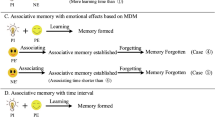Abstract
Although several kinds of computational associative memory models and emotion models have been proposed since the last century, the interaction between memory and emotion is almost always neglected in these conventional models. This study constructs a dynamic memory system, named the amygdala-hippocampus model, which intends to realize dynamic auto-association and the mutual association of time-series patterns more naturally by adopting an emotional factor, i.e., the functional model of the amygdala given by Morén and Balkenius. The output of the amygdala is designed to control the recollection state of multiple chaotic neural networks (MCNN) in CA3 of the hippocampus-neocortex model proposed in our early work. The efficiency of the proposed association system is verified by computer simulation using several benchmark time-series patterns.
Similar content being viewed by others
References
Kuremoto T, Eto T, Kobayashi K, et al (2005) A chaotic model of the hippocampus neocortex. LNCS (3610):439–448
Kuremoto T, Eto T, Obayashi M, et al (2005) A multilayered chaotic neural network for associative memory. Proceedings of the SICE Annual Conference, SICE, Tokyo, pp 1020–1023
Ito M, Miyake S, Inawashiro S, et al (2000) Long-term memory of temporal patterns in a hippocampus-cortex model (in Japanese). Tech Rep IEICE NLP 2000(18):25–32
Popescu AT, Saghyan AA, Paré D (2007) NMDA-dependent facilitation of corticostriatal plasticity by the amygdala. Proc Natl Acad Sci USA 104(1):341
Morén J, Balkenius C (2000) A computational model of emotional learning in the amygdala. Proceedings of the 6th International Conference on the Simulation of Adaptive Behavior, MIT, Cambridge, MA
Aihara K, Takabe T, Toyoda M (1990) Chaotic neural networks. Phys Lett A 144(6,7):333–340
Adachi M, Aihara K (1997) Associative dynamics in a chaotic neural network. Neural Networks (10):83–98
Balkenius C, Morén J (2000) Emotional learning: a computational model of the amygdala. Cybern Syst 32(6):611–636
Rouhani H, Jalili M, Araabi BN, et al (2007) A brain emotional learning-based intelligent controller applied to a neurofuzzy model of a micro-heat exchanger. Expert Syst Appl 32:911–918
Author information
Authors and Affiliations
Corresponding author
Additional information
This work was presented in part at the 13th International Symposium on Artificial Life and Robotics, Oita, Japan, January 31–February 2, 2008
About this article
Cite this article
Kuremoto, T., Ohta, T., Kobayashi, K. et al. A dynamic associative memory system by adopting an amygdala model. Artif Life Robotics 13, 478–482 (2009). https://doi.org/10.1007/s10015-008-0590-9
Received:
Accepted:
Published:
Issue Date:
DOI: https://doi.org/10.1007/s10015-008-0590-9




